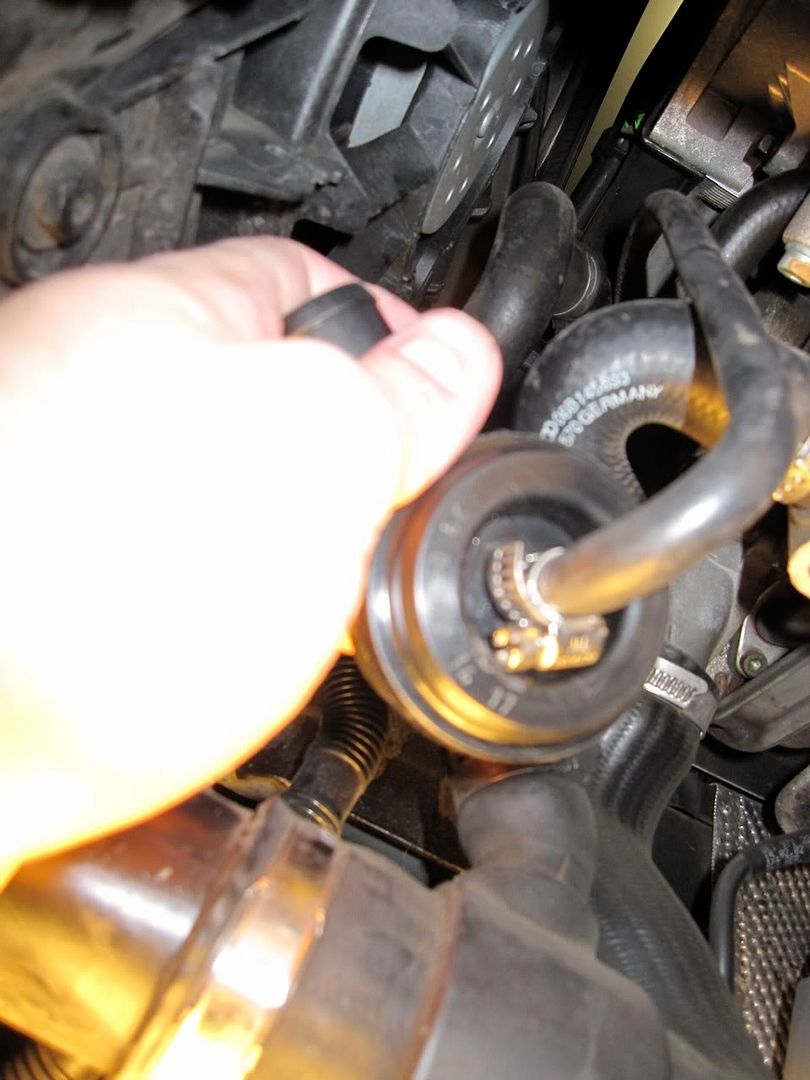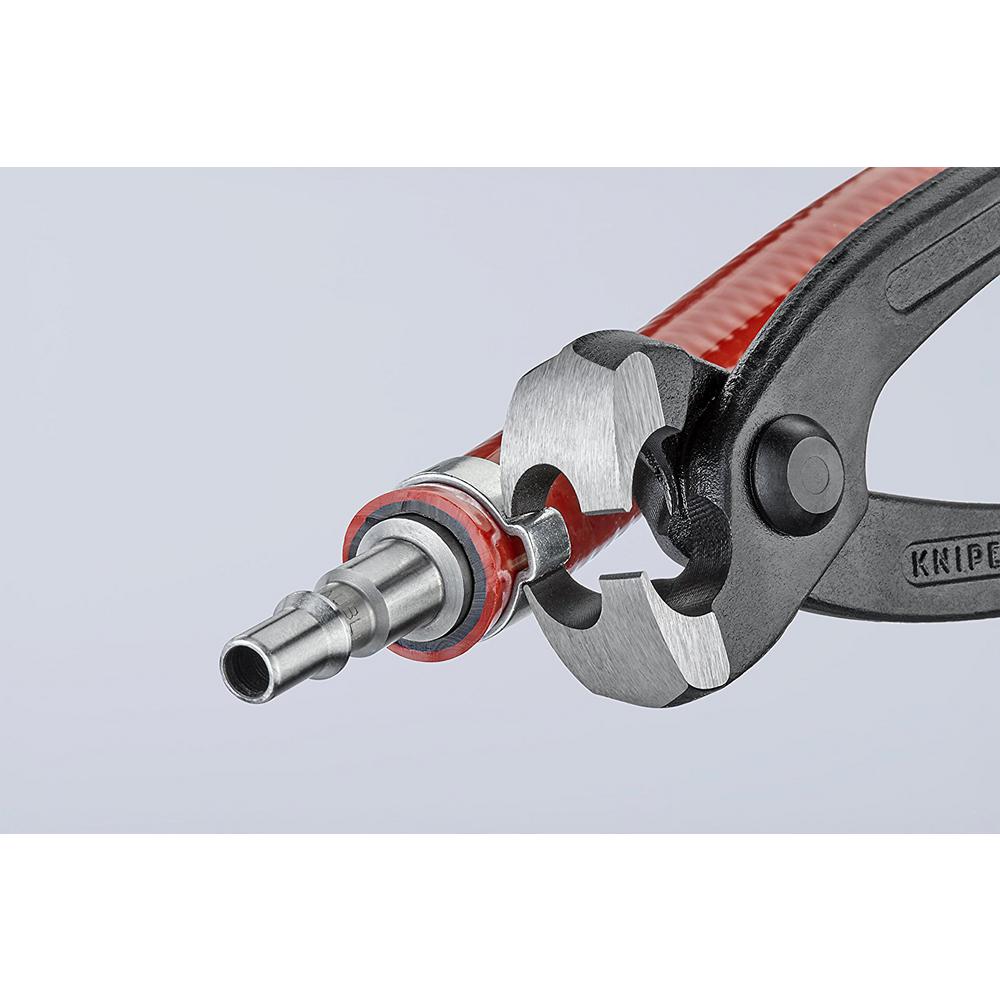My thoughts on clamps, but keep in mind I am a somewhat OCD engineer. Lol
I don't think the Oetiker Ear clamps are so great - virtually every old, small ear clamp on vacuum hoses of my 2002 Audi are loose i.e. the hoses are no longer clamped firmly because the rubber shrinks over time, and you really can only replace these clamps if they are already pinched to their minimum diameter. BTW I don't usually cut these off as it requires a pretty large and powerful wire cutter. I like to break the clamps where the band overlaps using a small pair of wire cutters or small, thin edge flat blade screw driver to start prying it up, as in Figure 1 and 2. I've been able to remove most clamps this way.
Worm clamps work well IMHO but only if you use ones that are going to be closed near their max diameter. If more than a 10mm range from max to minimum diameter, they do deform a lot if you tighten them to their smallest diameter, mainly due to the flat side of the screw mechanism. I like the German made Norma stainless clamps that have the rolled edges and the grooves are imprinted on the outside, not perforated, so that the worm screw doesn't tend to cut into the rubber. I found a store in S CA that has a decent assortment of Norma clamps, both 9mm and 12mm band widths:
CAP Hardware Supply. Worm clamps will be the most round, and the gear mechanism less likely to create gaps, if tightened close to their maximum diameter; you just need to get them big enough so they slip over the hose after it is pushed onto the nipple, or put them on the nipple, push the hose on, then work them over the hose so they don't have to slide over the bump. With some forethought when installing them, they can be oriented so that they can be tightened easily no matter what tight space they are located in. All the Norma clamps have a 7mm hex screw head - I prefer to keep all the clamps the same on the screw size so I don't have to switch sockets for different clamp styles.
The 8-12 x 9mm clamp (Figure 3) works well on the vacuum lines which tighten to around 11-12mm. The clamp can be opened to about 13mm and slips on easily.
Spring clamps: all the coolant hoses use the 12mm wide spring clamps. The problem with these clamps, although they are uniformly round and maintain constant clamp pressure, is that they can deform when pinching them open enough to get the hoses off - particularly old ones that have been heat tempered. I would say throw them away and buy new ones particularly if they have been pinched open more than once. They do deform, and the paint or black coating cracks and flakes off, and if measured you will see that their resting diameter is larger or out of round. Also compare a fresh clamp to a used clamp and you will see that you can pinch the used clamp slightly with just finger pressure.
For coolant hoses, most all of these clamp bands are 12mm wide which increases the surface area over which pressure is applied. I suspect for coolant hoses this spec is not just arbitrary. So, I am very reluctant to replace the spring clamps on coolant hoses with 9mm width worm clamps. Most of the worm clamps available are only 9mm band widths. There are some 12mm width Norma worm clamps which I have used, but more limited diameter ranges available. Once again IMHO the max diameter of these clamps should be chosen to be near to the closed diameter, because the 12mm wide Norma clamps are very, very stiff. I was going to use the 16-27x12mm Norma clamp (Figure 4) on the oil cooler hoses, but closing them down to 23mm, they deformed a lot and were not very round at all, so decided to stay with the OEM spring clamps. I usually try and shape my worm clamps to the target diameter before installing them by finding a hex socket with similar OD to the hose, and clamping the clamp around the socket as tight as possible and maybe use some heat. This certainly gives a good preview of gaps around the screw band. I find the 16-27x12mm worm clamps are just right for the ~3/4" ID coolant hoses which need about 26-27mm clamping diameter when closed.
Worm clamp torques? I have seen in the Bentley manual recommended torque of 2.5Nm for coolant hoses and 3.0Nm for air hoses, but don't know if this applies to worm screw clamps. Oetiker clamps can have closing torques too if the crimping tool supports it (food for thought).
Hose_Clamps.jpg
I signed onto this post to get opinions on using high pressure
fuel line clamps, particularly for the small diameter vacuum hoses.
Seems like I have read complaints about the bolts on these clamps loosening, more so than worm clamps. If that is true wouldn't locktite applied to the threads help? I certainly wouldn't want to go to the extent of safety wiring them. So definitely looking for feedback and experience using these.
Do some models have locknuts? Availability? Best brands? Suppliers?
Summary:
Oetiker style ear clamps:
Advantages:
- round and smooth when closed
Disadvantages:
- one time use
- difficult to remove
- can't be tightened over time
- must be precisely sized to the application
- need special tool to install
Spring style clamps:
Advantages:
- round and mostly smooth when closed (but still will leave impressions in the hose)
- maintain constant pressure over time and don't need to be re-tightened
Disadvantages:
- limited re-use; may deform each time they are pinched open
- more difficult to remove than worm clamps as much force is needed (vise grips vs. special tool)
- must be precisely sized to the application
Worm clamps:
Advantages:
- easily re-tightened
- no special tools required for installation or removal
- available in most corrosion resistant stainless steel
- one size clamp can fit many closed diameter ranges
- high re-usability
- can tighten these to spec with a normal torque wrench
- widely available and cheap
- some models can be opened and installed without having to slip off the hose
Disadvantages:
- some are better than others with regards to cutting into hoses
- when closed to minimum diameter may be out-of-round and less uniform pressure applied around entire hose
- still should be sized close to its maximum open diameter
- can break or strip screw if over tightened
Fuel-line/t-bolt clamps:
Advantages:
- very smooth and round when closed
- uniform clamping pressure
- easily re-tightened
- no special tools required for installation or removal
- available in most corrosion resistant stainless steel
- high re-usability
- can tighten these to spec with a normal torque wrench
Disadvantages:
- must be precisely sized to the application
- screw may tend to loosen (this is hearsay on my part; not confirmed)
- less commonly available in a wide variety of sizes than worm clamps














 Reply With Quote
Reply With Quote















Bookmarks